Question | Insulin is a kind of hormone which is produced from pancreas inside the human body.
VerifiedAdded on 2022/08/27
|7
|1495
|11
AI Summary
Contribute Materials
Your contribution can guide someone’s learning journey. Share your
documents today.
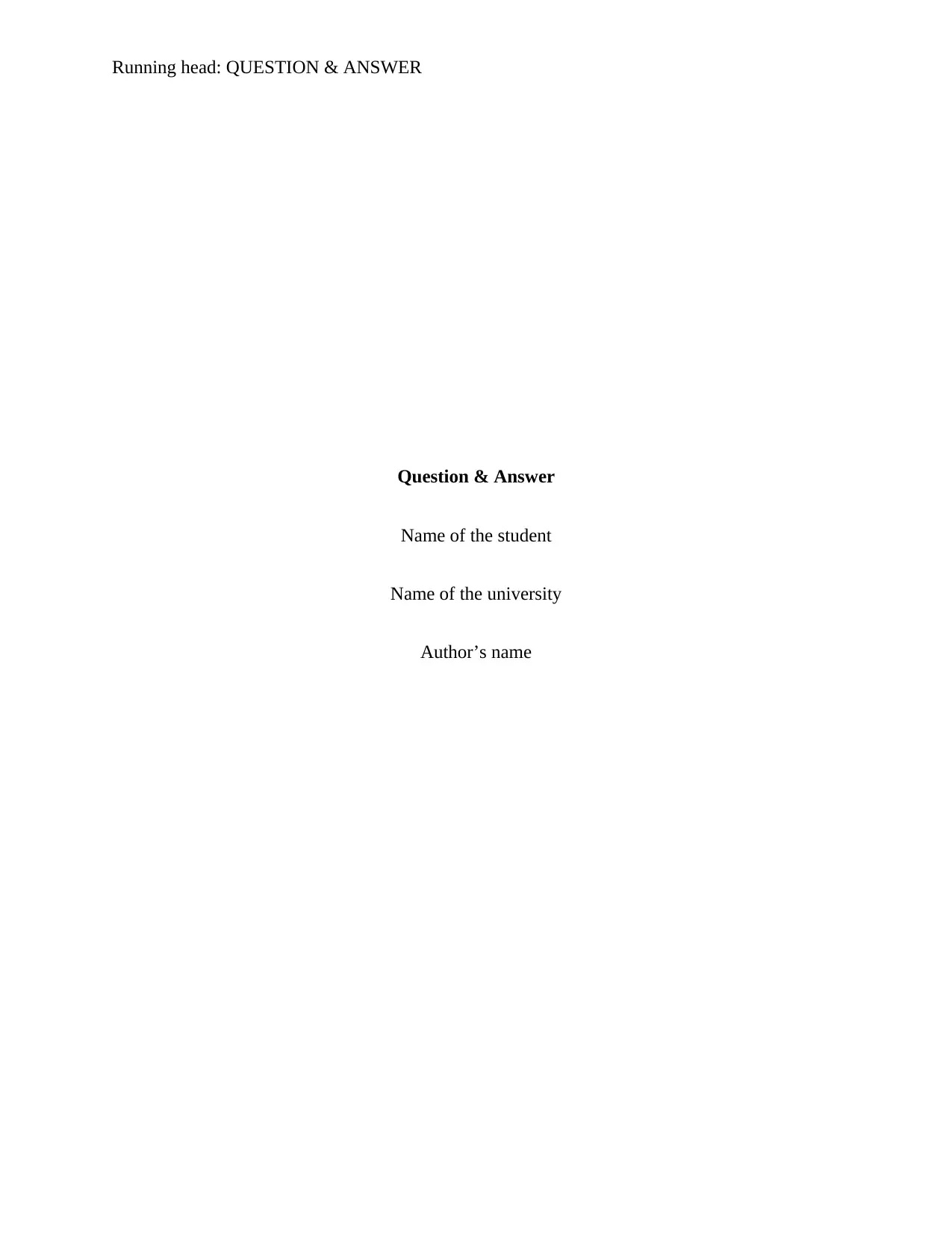
Running head: QUESTION & ANSWER
Question & Answer
Name of the student
Name of the university
Author’s name
Question & Answer
Name of the student
Name of the university
Author’s name
Secure Best Marks with AI Grader
Need help grading? Try our AI Grader for instant feedback on your assignments.
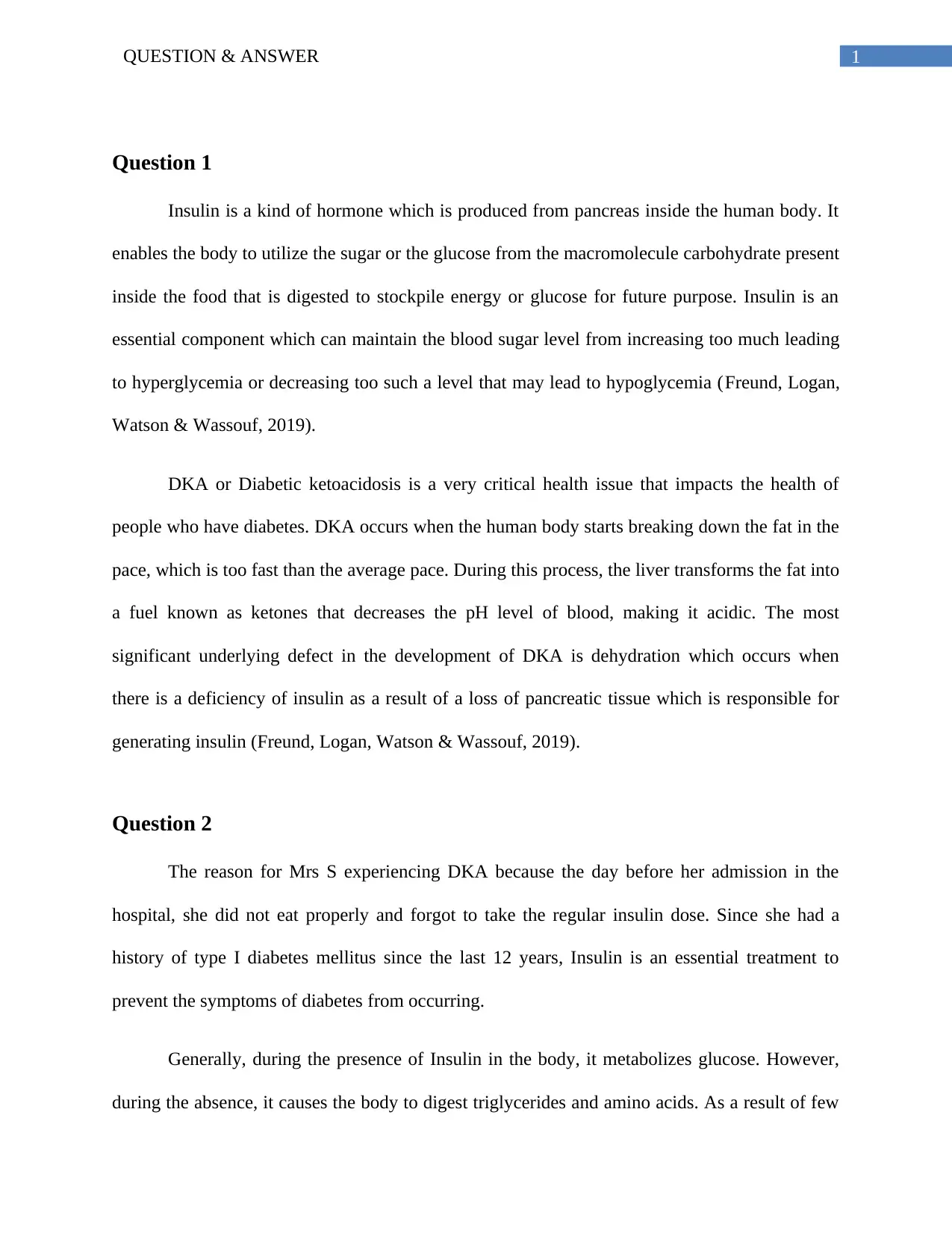
1QUESTION & ANSWER
Question 1
Insulin is a kind of hormone which is produced from pancreas inside the human body. It
enables the body to utilize the sugar or the glucose from the macromolecule carbohydrate present
inside the food that is digested to stockpile energy or glucose for future purpose. Insulin is an
essential component which can maintain the blood sugar level from increasing too much leading
to hyperglycemia or decreasing too such a level that may lead to hypoglycemia (Freund, Logan,
Watson & Wassouf, 2019).
DKA or Diabetic ketoacidosis is a very critical health issue that impacts the health of
people who have diabetes. DKA occurs when the human body starts breaking down the fat in the
pace, which is too fast than the average pace. During this process, the liver transforms the fat into
a fuel known as ketones that decreases the pH level of blood, making it acidic. The most
significant underlying defect in the development of DKA is dehydration which occurs when
there is a deficiency of insulin as a result of a loss of pancreatic tissue which is responsible for
generating insulin (Freund, Logan, Watson & Wassouf, 2019).
Question 2
The reason for Mrs S experiencing DKA because the day before her admission in the
hospital, she did not eat properly and forgot to take the regular insulin dose. Since she had a
history of type I diabetes mellitus since the last 12 years, Insulin is an essential treatment to
prevent the symptoms of diabetes from occurring.
Generally, during the presence of Insulin in the body, it metabolizes glucose. However,
during the absence, it causes the body to digest triglycerides and amino acids. As a result of few
Question 1
Insulin is a kind of hormone which is produced from pancreas inside the human body. It
enables the body to utilize the sugar or the glucose from the macromolecule carbohydrate present
inside the food that is digested to stockpile energy or glucose for future purpose. Insulin is an
essential component which can maintain the blood sugar level from increasing too much leading
to hyperglycemia or decreasing too such a level that may lead to hypoglycemia (Freund, Logan,
Watson & Wassouf, 2019).
DKA or Diabetic ketoacidosis is a very critical health issue that impacts the health of
people who have diabetes. DKA occurs when the human body starts breaking down the fat in the
pace, which is too fast than the average pace. During this process, the liver transforms the fat into
a fuel known as ketones that decreases the pH level of blood, making it acidic. The most
significant underlying defect in the development of DKA is dehydration which occurs when
there is a deficiency of insulin as a result of a loss of pancreatic tissue which is responsible for
generating insulin (Freund, Logan, Watson & Wassouf, 2019).
Question 2
The reason for Mrs S experiencing DKA because the day before her admission in the
hospital, she did not eat properly and forgot to take the regular insulin dose. Since she had a
history of type I diabetes mellitus since the last 12 years, Insulin is an essential treatment to
prevent the symptoms of diabetes from occurring.
Generally, during the presence of Insulin in the body, it metabolizes glucose. However,
during the absence, it causes the body to digest triglycerides and amino acids. As a result of few
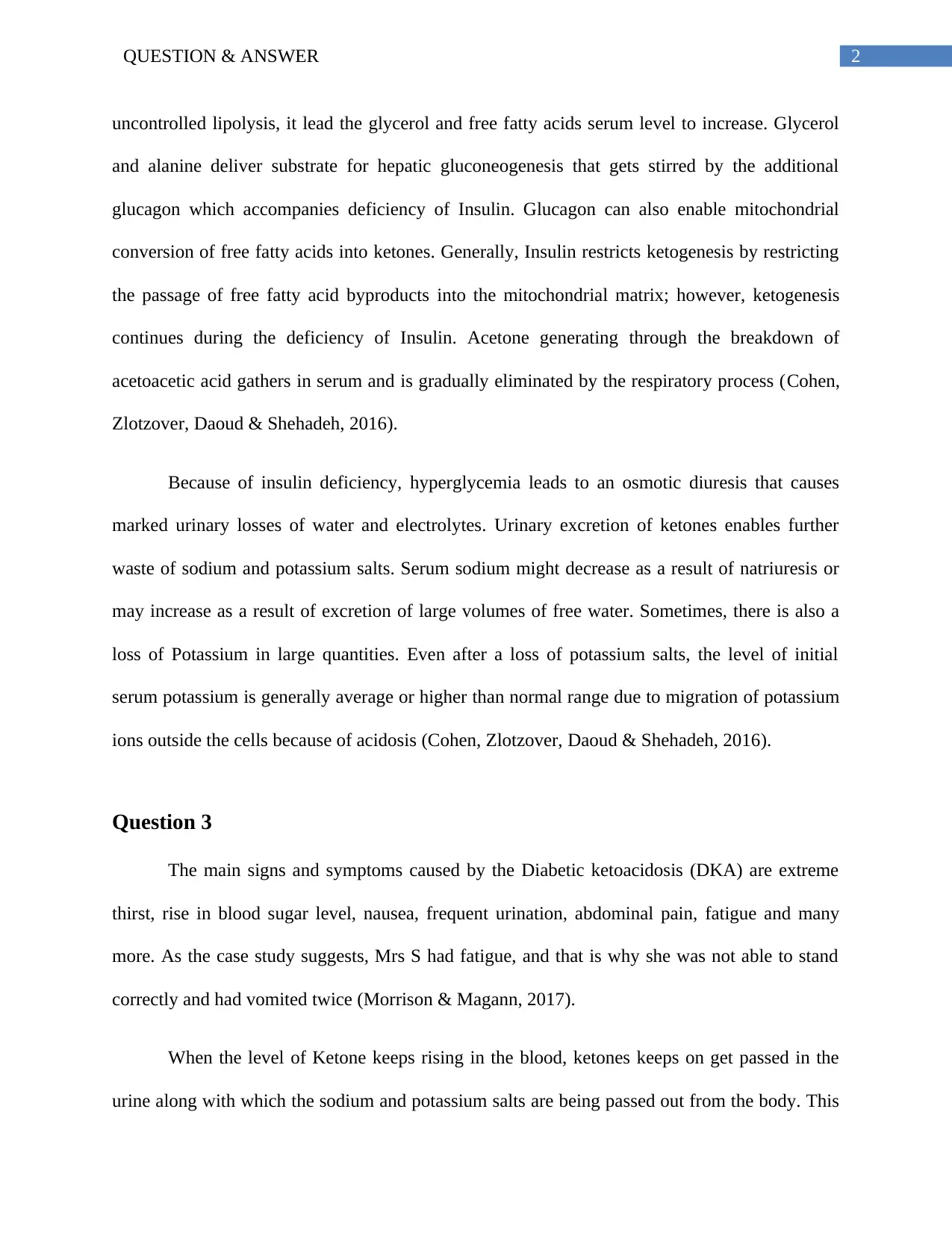
2QUESTION & ANSWER
uncontrolled lipolysis, it lead the glycerol and free fatty acids serum level to increase. Glycerol
and alanine deliver substrate for hepatic gluconeogenesis that gets stirred by the additional
glucagon which accompanies deficiency of Insulin. Glucagon can also enable mitochondrial
conversion of free fatty acids into ketones. Generally, Insulin restricts ketogenesis by restricting
the passage of free fatty acid byproducts into the mitochondrial matrix; however, ketogenesis
continues during the deficiency of Insulin. Acetone generating through the breakdown of
acetoacetic acid gathers in serum and is gradually eliminated by the respiratory process (Cohen,
Zlotzover, Daoud & Shehadeh, 2016).
Because of insulin deficiency, hyperglycemia leads to an osmotic diuresis that causes
marked urinary losses of water and electrolytes. Urinary excretion of ketones enables further
waste of sodium and potassium salts. Serum sodium might decrease as a result of natriuresis or
may increase as a result of excretion of large volumes of free water. Sometimes, there is also a
loss of Potassium in large quantities. Even after a loss of potassium salts, the level of initial
serum potassium is generally average or higher than normal range due to migration of potassium
ions outside the cells because of acidosis (Cohen, Zlotzover, Daoud & Shehadeh, 2016).
Question 3
The main signs and symptoms caused by the Diabetic ketoacidosis (DKA) are extreme
thirst, rise in blood sugar level, nausea, frequent urination, abdominal pain, fatigue and many
more. As the case study suggests, Mrs S had fatigue, and that is why she was not able to stand
correctly and had vomited twice (Morrison & Magann, 2017).
When the level of Ketone keeps rising in the blood, ketones keeps on get passed in the
urine along with which the sodium and potassium salts are being passed out from the body. This
uncontrolled lipolysis, it lead the glycerol and free fatty acids serum level to increase. Glycerol
and alanine deliver substrate for hepatic gluconeogenesis that gets stirred by the additional
glucagon which accompanies deficiency of Insulin. Glucagon can also enable mitochondrial
conversion of free fatty acids into ketones. Generally, Insulin restricts ketogenesis by restricting
the passage of free fatty acid byproducts into the mitochondrial matrix; however, ketogenesis
continues during the deficiency of Insulin. Acetone generating through the breakdown of
acetoacetic acid gathers in serum and is gradually eliminated by the respiratory process (Cohen,
Zlotzover, Daoud & Shehadeh, 2016).
Because of insulin deficiency, hyperglycemia leads to an osmotic diuresis that causes
marked urinary losses of water and electrolytes. Urinary excretion of ketones enables further
waste of sodium and potassium salts. Serum sodium might decrease as a result of natriuresis or
may increase as a result of excretion of large volumes of free water. Sometimes, there is also a
loss of Potassium in large quantities. Even after a loss of potassium salts, the level of initial
serum potassium is generally average or higher than normal range due to migration of potassium
ions outside the cells because of acidosis (Cohen, Zlotzover, Daoud & Shehadeh, 2016).
Question 3
The main signs and symptoms caused by the Diabetic ketoacidosis (DKA) are extreme
thirst, rise in blood sugar level, nausea, frequent urination, abdominal pain, fatigue and many
more. As the case study suggests, Mrs S had fatigue, and that is why she was not able to stand
correctly and had vomited twice (Morrison & Magann, 2017).
When the level of Ketone keeps rising in the blood, ketones keeps on get passed in the
urine along with which the sodium and potassium salts are being passed out from the body. This
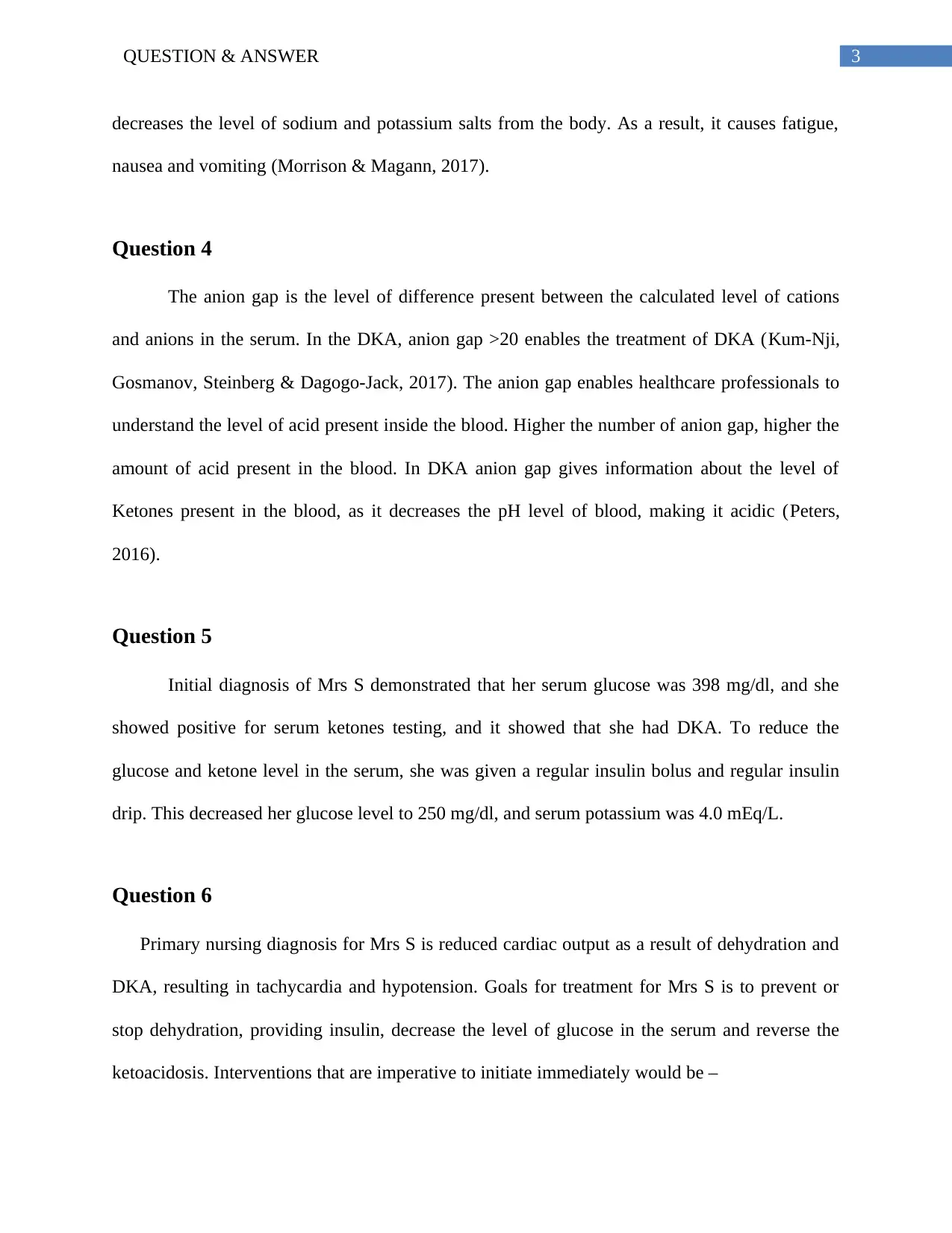
3QUESTION & ANSWER
decreases the level of sodium and potassium salts from the body. As a result, it causes fatigue,
nausea and vomiting (Morrison & Magann, 2017).
Question 4
The anion gap is the level of difference present between the calculated level of cations
and anions in the serum. In the DKA, anion gap >20 enables the treatment of DKA (Kum-Nji,
Gosmanov, Steinberg & Dagogo-Jack, 2017). The anion gap enables healthcare professionals to
understand the level of acid present inside the blood. Higher the number of anion gap, higher the
amount of acid present in the blood. In DKA anion gap gives information about the level of
Ketones present in the blood, as it decreases the pH level of blood, making it acidic (Peters,
2016).
Question 5
Initial diagnosis of Mrs S demonstrated that her serum glucose was 398 mg/dl, and she
showed positive for serum ketones testing, and it showed that she had DKA. To reduce the
glucose and ketone level in the serum, she was given a regular insulin bolus and regular insulin
drip. This decreased her glucose level to 250 mg/dl, and serum potassium was 4.0 mEq/L.
Question 6
Primary nursing diagnosis for Mrs S is reduced cardiac output as a result of dehydration and
DKA, resulting in tachycardia and hypotension. Goals for treatment for Mrs S is to prevent or
stop dehydration, providing insulin, decrease the level of glucose in the serum and reverse the
ketoacidosis. Interventions that are imperative to initiate immediately would be –
decreases the level of sodium and potassium salts from the body. As a result, it causes fatigue,
nausea and vomiting (Morrison & Magann, 2017).
Question 4
The anion gap is the level of difference present between the calculated level of cations
and anions in the serum. In the DKA, anion gap >20 enables the treatment of DKA (Kum-Nji,
Gosmanov, Steinberg & Dagogo-Jack, 2017). The anion gap enables healthcare professionals to
understand the level of acid present inside the blood. Higher the number of anion gap, higher the
amount of acid present in the blood. In DKA anion gap gives information about the level of
Ketones present in the blood, as it decreases the pH level of blood, making it acidic (Peters,
2016).
Question 5
Initial diagnosis of Mrs S demonstrated that her serum glucose was 398 mg/dl, and she
showed positive for serum ketones testing, and it showed that she had DKA. To reduce the
glucose and ketone level in the serum, she was given a regular insulin bolus and regular insulin
drip. This decreased her glucose level to 250 mg/dl, and serum potassium was 4.0 mEq/L.
Question 6
Primary nursing diagnosis for Mrs S is reduced cardiac output as a result of dehydration and
DKA, resulting in tachycardia and hypotension. Goals for treatment for Mrs S is to prevent or
stop dehydration, providing insulin, decrease the level of glucose in the serum and reverse the
ketoacidosis. Interventions that are imperative to initiate immediately would be –
Secure Best Marks with AI Grader
Need help grading? Try our AI Grader for instant feedback on your assignments.
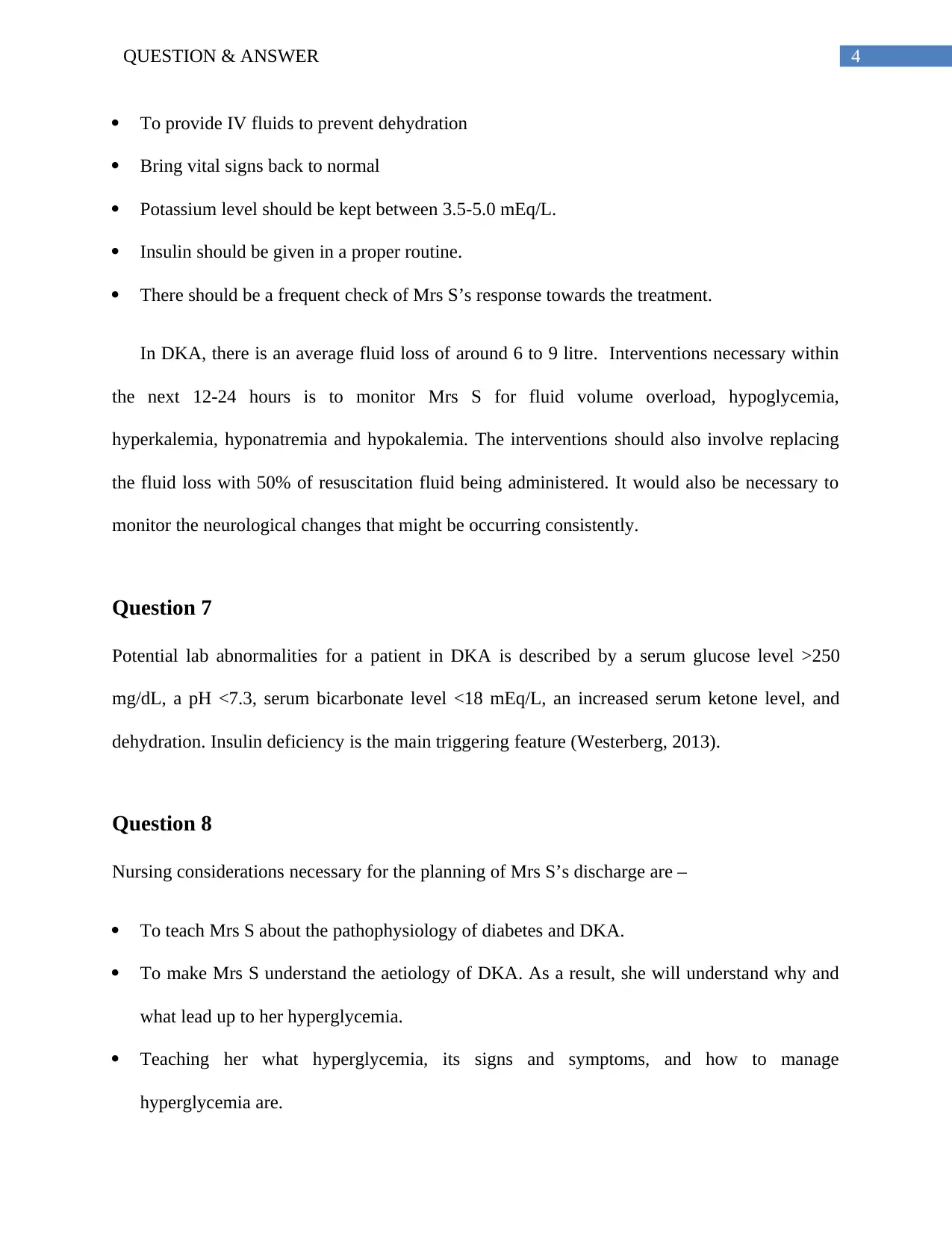
4QUESTION & ANSWER
To provide IV fluids to prevent dehydration
Bring vital signs back to normal
Potassium level should be kept between 3.5-5.0 mEq/L.
Insulin should be given in a proper routine.
There should be a frequent check of Mrs S’s response towards the treatment.
In DKA, there is an average fluid loss of around 6 to 9 litre. Interventions necessary within
the next 12-24 hours is to monitor Mrs S for fluid volume overload, hypoglycemia,
hyperkalemia, hyponatremia and hypokalemia. The interventions should also involve replacing
the fluid loss with 50% of resuscitation fluid being administered. It would also be necessary to
monitor the neurological changes that might be occurring consistently.
Question 7
Potential lab abnormalities for a patient in DKA is described by a serum glucose level >250
mg/dL, a pH <7.3, serum bicarbonate level <18 mEq/L, an increased serum ketone level, and
dehydration. Insulin deficiency is the main triggering feature (Westerberg, 2013).
Question 8
Nursing considerations necessary for the planning of Mrs S’s discharge are –
To teach Mrs S about the pathophysiology of diabetes and DKA.
To make Mrs S understand the aetiology of DKA. As a result, she will understand why and
what lead up to her hyperglycemia.
Teaching her what hyperglycemia, its signs and symptoms, and how to manage
hyperglycemia are.
To provide IV fluids to prevent dehydration
Bring vital signs back to normal
Potassium level should be kept between 3.5-5.0 mEq/L.
Insulin should be given in a proper routine.
There should be a frequent check of Mrs S’s response towards the treatment.
In DKA, there is an average fluid loss of around 6 to 9 litre. Interventions necessary within
the next 12-24 hours is to monitor Mrs S for fluid volume overload, hypoglycemia,
hyperkalemia, hyponatremia and hypokalemia. The interventions should also involve replacing
the fluid loss with 50% of resuscitation fluid being administered. It would also be necessary to
monitor the neurological changes that might be occurring consistently.
Question 7
Potential lab abnormalities for a patient in DKA is described by a serum glucose level >250
mg/dL, a pH <7.3, serum bicarbonate level <18 mEq/L, an increased serum ketone level, and
dehydration. Insulin deficiency is the main triggering feature (Westerberg, 2013).
Question 8
Nursing considerations necessary for the planning of Mrs S’s discharge are –
To teach Mrs S about the pathophysiology of diabetes and DKA.
To make Mrs S understand the aetiology of DKA. As a result, she will understand why and
what lead up to her hyperglycemia.
Teaching her what hyperglycemia, its signs and symptoms, and how to manage
hyperglycemia are.

5QUESTION & ANSWER
Also, train her regarding the management of insulin and diet for those times when she does
not feel like eating or would not be in a condition to eat.
Her family members will be involved during all this process so that they can give Mrs S
family support.
Also, train her regarding the management of insulin and diet for those times when she does
not feel like eating or would not be in a condition to eat.
Her family members will be involved during all this process so that they can give Mrs S
family support.
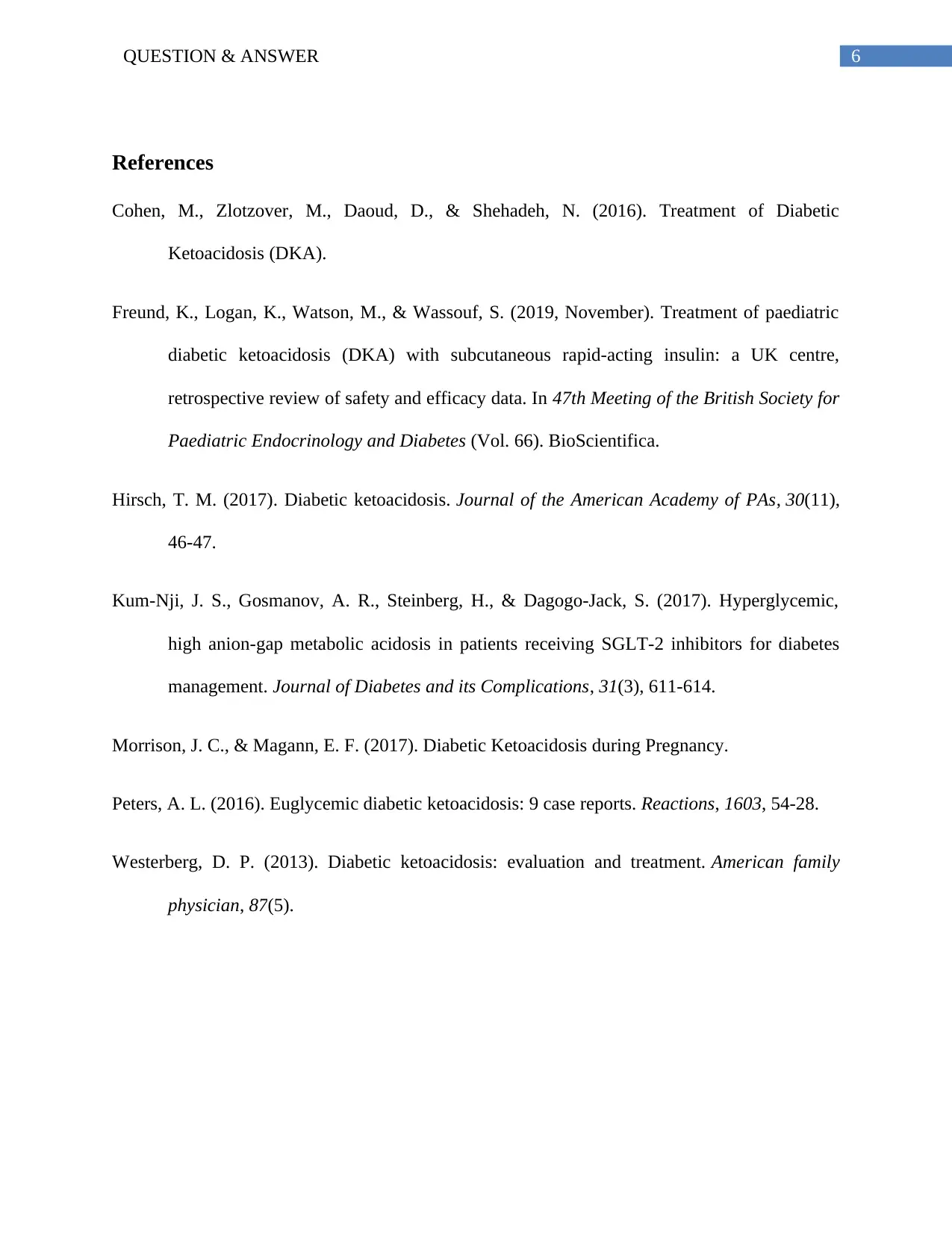
6QUESTION & ANSWER
References
Cohen, M., Zlotzover, M., Daoud, D., & Shehadeh, N. (2016). Treatment of Diabetic
Ketoacidosis (DKA).
Freund, K., Logan, K., Watson, M., & Wassouf, S. (2019, November). Treatment of paediatric
diabetic ketoacidosis (DKA) with subcutaneous rapid-acting insulin: a UK centre,
retrospective review of safety and efficacy data. In 47th Meeting of the British Society for
Paediatric Endocrinology and Diabetes (Vol. 66). BioScientifica.
Hirsch, T. M. (2017). Diabetic ketoacidosis. Journal of the American Academy of PAs, 30(11),
46-47.
Kum-Nji, J. S., Gosmanov, A. R., Steinberg, H., & Dagogo-Jack, S. (2017). Hyperglycemic,
high anion-gap metabolic acidosis in patients receiving SGLT-2 inhibitors for diabetes
management. Journal of Diabetes and its Complications, 31(3), 611-614.
Morrison, J. C., & Magann, E. F. (2017). Diabetic Ketoacidosis during Pregnancy.
Peters, A. L. (2016). Euglycemic diabetic ketoacidosis: 9 case reports. Reactions, 1603, 54-28.
Westerberg, D. P. (2013). Diabetic ketoacidosis: evaluation and treatment. American family
physician, 87(5).
References
Cohen, M., Zlotzover, M., Daoud, D., & Shehadeh, N. (2016). Treatment of Diabetic
Ketoacidosis (DKA).
Freund, K., Logan, K., Watson, M., & Wassouf, S. (2019, November). Treatment of paediatric
diabetic ketoacidosis (DKA) with subcutaneous rapid-acting insulin: a UK centre,
retrospective review of safety and efficacy data. In 47th Meeting of the British Society for
Paediatric Endocrinology and Diabetes (Vol. 66). BioScientifica.
Hirsch, T. M. (2017). Diabetic ketoacidosis. Journal of the American Academy of PAs, 30(11),
46-47.
Kum-Nji, J. S., Gosmanov, A. R., Steinberg, H., & Dagogo-Jack, S. (2017). Hyperglycemic,
high anion-gap metabolic acidosis in patients receiving SGLT-2 inhibitors for diabetes
management. Journal of Diabetes and its Complications, 31(3), 611-614.
Morrison, J. C., & Magann, E. F. (2017). Diabetic Ketoacidosis during Pregnancy.
Peters, A. L. (2016). Euglycemic diabetic ketoacidosis: 9 case reports. Reactions, 1603, 54-28.
Westerberg, D. P. (2013). Diabetic ketoacidosis: evaluation and treatment. American family
physician, 87(5).
1 out of 7
Related Documents
Your All-in-One AI-Powered Toolkit for Academic Success.
+13062052269
info@desklib.com
Available 24*7 on WhatsApp / Email
![[object Object]](/_next/static/media/star-bottom.7253800d.svg)
Unlock your academic potential
© 2024 | Zucol Services PVT LTD | All rights reserved.





